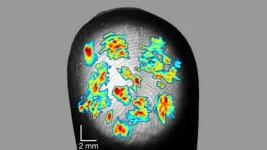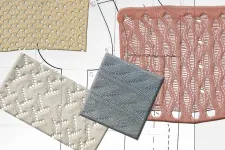(Press-News.org) Prior to COVID-19, communication via the internet was already a regular feature of everyday interactions for most people, including those on the autism spectrum. Various studies have shown how autistic people use information and communication technology (ICT) since the early 2000s, some finding that autistic people may prefer to communicate using the internet instead of in-person. However, no systematic review has been conducted to summarize these findings.
To understand what has been discovered so far, researchers from Drexel University's A.J. Drexel Autism Institute collected and reviewed published research about how autistic youth and adults use the internet to communicate and provide a framework for understanding contributions, gaps and opportunities in online autistic communities.
Lead author Elizabeth McGhee Hassrick, PhD, an assistant professor in the Autism Institute, and her co-authors cast a wide net searching across five databases that list studies investigating how autistic people use the internet to communicate. Filtering for specific criteria, they read 32 articles, collected their most important findings and looked for patterns.
Of those 32 studies, 19 used closed-ended survey questions, 12 studies used open ended interviews and looked for patterns and connections among participants and one was a mixed methods study. In total, 3,026 autistic youth ages 10-17 and adults participated in the studies they reviewed.
Three main themes emerged from the review: differences in the ways that autistic youth and adults used the internet to communicate, benefits and drawbacks experienced during internet communication and the engagement of autistic youth and adults in the online autism community.
The review found some of the benefits of social media for autistic people include more control over how they talk and engage with others online and a greater sense of calm during interactions. Social media provides opportunities for autistic people to find others on the autism spectrum and form a stronger identity as part of the autism community. However, findings also suggest that some autistic people continue to be lonely and desire in-person relationships despite cultivating social media friendships.
"Further exploration of the positive social benefits that autistic people gain participating in online autism communities would allow for the development of strengths-based interventions," said McGhee Hassrick. "For example, additional research on how autistic people navigate sexuality and ICTs is needed to identify ways for reducing vulnerability online."
McGhee Hassrick added that this study can help identify gaps and opportunities for new research, support the importance of online autistic communities and suggest possible training opportunities about how to support autistic people when they use the internet for communication.
"We learned that the evidence base is emerging, meaning that more rigorous, high-quality studies are needed," said McGhee Hassrick. "Also, many autistic people were underrepresented in the study. There is little research about autistic women, autistic transgender people, autistic racial/ethnic minorities or autistic people from lower socioeconomic groups."
INFORMATION:
The study, "Benefits and Risks: A Systematic Review of Information and Communication Technology Use by Autistic People," was recently published in Autism in Adulthood. Co-authors include Laura Graham Holmes, PhD, of CUNY Hunter College; Jessica Walton of Drexel University; Collette Sosnowy, PhD, of Brown University; and Kathleen Carley, PhD, of Carnegie Mellon University.
(BOSTON) ¬-- Trillions of commensal microbes live on the mucosal and epidermal surfaces of the body and it is firmly established that this microbiome affects its host's tolerance and sensitivity of the host to a variety of pathogens. However, host tolerance to infection with pathogens is not equally developed in all organisms. For example, it is known that the gut microbiome of mice protects more effectively against infection with certain pathogens, such as the bacterium Salmonella typhimurium, than the human gut microbiome.
This raises the interesting possibility that analyzing differences between host-microbiome ...
TORONTO, ON - Research by a team of chemists at the University of Toronto, led by Nobel Prize-winning researcher John Polanyi, is shedding new light on the behaviour of molecules as they collide and exchange atoms during chemical reaction. The discovery casts doubt on a 90-year old theoretical model of the behavior of the "transition state", intermediate between reagents and products in chemical reactions, opening a new area of research.
The researchers studied collisions obtained by launching a fluorine atom at the centre of a fluoromethyl molecule - made up of one carbon atom and three fluorine atoms - and observed the resulting reaction using Scanning Tunneling Microscopy. What they saw following each collision ...
Fingerprints may be more useful to us than helping us nab criminal suspects: they also improve our sense of touch. Sensory neurons in the finger can detect touch on the scale of a single fingerprint ridge, according to new research published in JNeurosci.
The hand contains tens of thousands of sensory neurons. Each neuron tunes in to a small surface area on the skin -- a receptive field -- and detects touch, vibration, pressure, and other tactile stimuli. The human hand possesses a refined sense of touch, but the exact sensitivity of a single sensory neuron has not been studied before.
To ...
Key Points
19.3% of children and adolescents in the United States have obesity and therefore have a higher likelihood of having obesity as adults and developing weight-related diseases.
This AJCN study assessed how strongly mothers' diets during pregnancy were associated with their children's growth rates during specific periods from birth through adolescence.
Study results suggest maternal nutrition during pregnancy may influence her offspring's weight gain during specific periods from birth to adolescence.
A pregnancy diet with higher inflammatory potential was associated with accelerated BMI growth trajectories in children, specifically those between three and ten years of age.
Rockville, ...
Recent summer droughts in Europe are far more severe than anything in the past 2,100 years, according to a new study.
An international team, led by the University of Cambridge, studied the chemical fingerprints in European oak trees to reconstruct summer climate over 2,110 years. They found that after a long-term drying trend, drought conditions since 2015 suddenly intensified, beyond anything in the past two thousand years.
This anomaly is likely the result of human-caused climate change and associated shifts in the jet stream. The results are reported in the journal Nature Geoscience.
Recent summer droughts and heatwaves in Europe have had devastating ecological and economic consequences, which will worsen as the global climate continues to warm.
"We're ...
In their study, which is now published in the journal Nature Aging, they show that the level of non-coding RNAs in the blood of a Parkinson's patient can be used to track the course of the disease. For their study, the team led by bioinformatics professor Andreas Keller and his doctoral student Fabian Kern created and analyzed the molecular profiles of more than 5,000 blood samples from over 1,600 Parkinson's patients. This resulted in around 320 billion data points, which the researchers analyzed for biomarkers of Parkinson's disease using artificial intelligence methods. ...
DURHAM, N.C. -- Researchers at Duke University have revealed long-hidden molecular dynamics that provide desirable properties for solar energy and heat energy applications to an exciting class of materials called halide perovskites.
A key contributor to how these materials create and transport electricity literally hinges on the way their atomic lattice twists and turns in a hinge-like fashion. The results will help materials scientists in their quest to tailor the chemical recipes of these materials for a wide range of applications in an environmentally friendly way.
The results appear online March 15 in the journal Nature Materials.
"There is a broad ...
An epigenetic modification that occurs in a major cell type in the brain's reward circuitry controls how stress early in life increases susceptibility to additional stress in adulthood, researchers at the Icahn School of Medicine at Mount Sinai have learned. In a study in Nature Neuroscience, the team also reported that a small-molecule inhibitor of the enzyme responsible for this modification, currently being developed as an anti-cancer drug, was able to reverse increased vulnerability to lifelong stress in animal models.
"It has long been known that stress exposures throughout life control lifelong susceptibility to subsequent stress. Here ...
Researchers have found that out of the more than 300 COVID-19 machine learning models described in scientific papers in 2020, none of them is suitable for detecting or diagnosing COVID-19 from standard medical imaging, due to biases, methodological flaws, lack of reproducibility, and 'Frankenstein datasets.'
The team of researchers, led by the University of Cambridge, carried out a systematic review of scientific manuscripts - published between 1 January and 3 October 2020 - describing machine learning models that claimed to be able to diagnose or prognosticate ...
In considering materials that could become the fabrics of the future, scientists have largely dismissed one widely available option: polyethylene.
The stuff of plastic wrap and grocery bags, polyethylene is thin and lightweight, and could keep you cooler than most textiles because it lets heat through rather than trapping it in. But polyethylene would also lock in water and sweat, as it's unable to draw away and evaporate moisture. This antiwicking property has been a major deterrent to polyethylene's adoption as a wearable textile.
Now, MIT engineers have spun polyethylene into fibers ...







